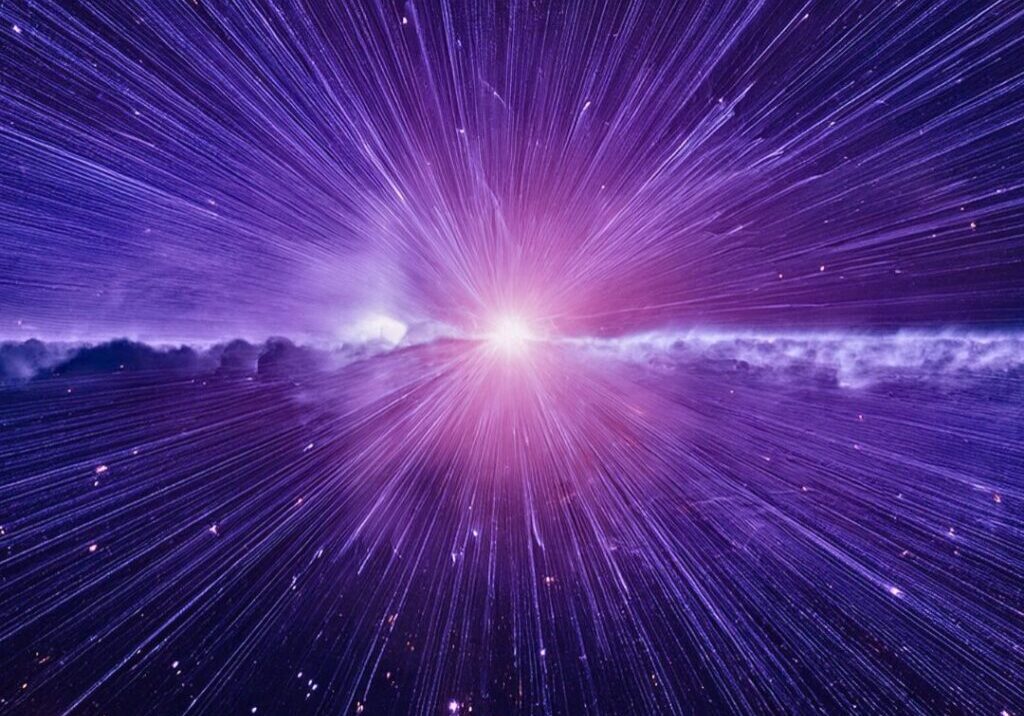Pierre Teilhard de Chardin and Thomas Berry: Interiority and Subjectivity
Thomas Berry regarded the influence from Teilhard as integral to his thought. They were both concerned with the value and beauty of the universe as well as a commitment to the deeper implications of matter in understanding the human spiritual journey. This stands in sharp contrast to otherworldly values and forms of redemption out of a fallen material world. Quite pointedly, Teilhard argued for a “zeal for creation.” [Teilhard, “The Sense of Man,” Toward the Future. (London: Collins, 1975), 32.] Both Berry and Teilhard struggled to rethink the roles of traditional religious cosmologies in light of the scientific story of an evolving universe. They each wanted to reconsider the Christian commitment to a separate creation of the human by a transcendent Creator. They also realized that their positions went contrary to most natural scientists who favored a strictly materialist interpretation of evolution. Scientists positioned the human, by virtue of rational consciousness, as anomalous and different from the mainstream of evolution. In this reductive view often found among scientists, philosophers, and religious thinkers, subjectivity resides only in the human.
On Subjectivity, Consciousness, Interiority in the Universe
Both Teilhard and Thomas Berry had a different view of subjectivity, consciousness, or interiority; namely, as a dimension of the entire evolutionary process. It was this affirmation of the human as integral with the whole of cosmic emergence that gave Teilhard and Berry a common sense of vision and purpose. For with this comprehensive vision came an appreciation of the zest for life and its future flourishing. They knew cosmological zest and human energy had to be activated for building a viable future for both humans and the larger Earth community. They called this the Great Work.
Ursula King has described this kind of zest as “a certain dynamic energy and movement, an aliveness that spurs us on, nourishes and sustains human attitudes, inspiring further action, growth and development, or it is simply understood as an alignment with the flow of life.” [“The Zest for Life: A Contemporary Exploration of a Generative Theme in Teilhard’s Work,” Ilia Delio, ed. From Teilhard to Omega. Co-creating an Unfinished Universe. Maryknoll, NY: Orbis Books 2014, 7.] This alignment of human and Earth creativity is what Teilhard and Berry sought to encourage for the benefit of the Earth community. Such alignment is indeed emerging, for example, in ecocities, eco-design, biomimicry, and in new sources of energy relying on wind, sun, and water. [For ecocities see ecocitybuilders.org and for eco-design see William McDonough and Michael Braungart, Cradle to Cradle: Remaking the Way We Make Things. New York: North Point Press, 2002. For biomimicry see Janine Benyus, Biomimicry: Innovation Inspired by Nature. New York, Harper Perennial, 2002.]
Teilhard’s Interiority and Thomas Berry’s Subjectivity
Throughout his writings, Teilhard describes evolution as both a physical and psychic process; matter has its physical without and its psychic within. [See e.g., John Grim and Mary Evelyn Tucker, “Teilhard’s Vision of Evolution,” Teilhard Studies #50, American Teilhard Association, Spring 2005.] This is what Teilhard called interiority and Berry called subjectivity—as in his well-known phrase on the universe as “a communion of subjects.” [See e.g. Thomas Berry, “The Meadow Across the Creek,” The Great Work. (New York: Bell Towers, 1999), 16.] Their justification for such a view of inwardness in matter lies in inductive observation, namely if interiority exists at one point (as in human consciousness) it must exist throughout the evolutionary process. [The theme of interiority is central to John Haught’s book, The New Cosmic Story, Inside Our Awakening Universe. New Haven: Yale University Press, 2017.] This becomes evident in the increase in complexity and consciousness over the arc of evolutionary time. In this sense, human consciousness is not situated as an aberration or addendum, but as arising from out of the evolutionary process. Teilhard asserts:
…deep within ourselves, through a rent or tear, an ‘interior’ appears at the heart of beings. This is enough to establish the existence of this interior in some degree or other everywhere forever in nature. Since the stuff of the universe has an internal face at one point in itself, its structure is necessarily bifacial; that is, in every region of time and space, as well, for example, as being granular [material], coextensive with its outside, everything has an inside [spiritual]. [The Human Phenomenon, 24.]
Teilhard saw the physical and psychic dimension of evolution as matter and spirit, differentiated yet intertwined aspects of reality. [Ursula King, Spirit of Fire: The Life and Vision of Teilhard de Chardin. Maryknoll, NY: Orbis Books, 2015.]
For Teilhard, “spirit” was the “within” of all existence in the universe, inseparable from the visible, material “without” that humans could see, namely, matter. [See reflections on this by Mary Evelyn Tucker, “The Ecological Spirituality of Teilhard.” Teilhard Studies # 51 (American Teilhard Association, Fall 2005). Published in Kathleen Duffy, ed. Rediscovering Teilhard’s Fire. Philadelphia: St. Joseph’s University Press, 2010. See also Ursula King, “Ecology and Spirituality: A New Earth Consciousness and a New Earth Community,” Christ in All Things: Exploring Spirituality with Teilhard de Chardin. Maryknoll, NY: Orbis Books 2016, 165-194.]
In Teilhard’s perspective, the elements of the universe are entangled in the process of evolution pulled forward by the “within” of dynamic spirit. Teilhard describes this interior energy as drawing matter forward into patterns that result in greater complexity and consciousness. Teilhard observes that there are self-organizing principles or tendencies evident in matter that give rise to more intricate systems. [Ilya Prigogene’s research showed that “dissipative structures can lead to self-organizing dynamics manifest in evolutionary processes. See Ilya Prigogene and Isabella Stengers, Order Out of Chaos: Man’s New Dialogue with Nature. London: William Heinemann Ltd, 1984.]
From the first flaring forth of radiant particles to its present configuration, the universe has had a quantum of spirit—an interiority—that evolved inexorably towards a point that Teilhard named omega. [For Teilhard, omega has two distinct usages with broader implications: first, omega is definitely a central idea within the evolutionary process analogous to his usage of “spirit,” “Spirit of the Earth,” and “christic,” but it is not limited to that. Second, omega is also a transcendent term for the culminating convergence beyond evolution. See The Human Phenomenon, 192-193.] Another phrase that Teilhard used for this universe process as it manifested on our planet was “the Spirit of the Earth.” [Teilhard, “The Spirit of the Earth,” Human Energy. New York: Harcourt Brace Jovanovich, 1969, 19-47.] Berry affirmed and expanded this insight saying, “The spirituality of the Earth refers to a quality of the Earth itself, not a human spirituality with special reference to the planet Earth….The human and the Earth are totally implicated, each in the other. If there is no spirituality in Earth, then there is no spirituality in us.” [Thomas Berry, “The Spirituality of the Earth,” The Sacred Universe. New York: Columbia University Press, 2009, 69.]
In Teilhard’s view, matter-spirit evolved and encircled the planet. On Earth successive evolutionary spheres became the lithosphere of rock, the hydrosphere of water, and, eventually, the biosphere of life surrounding the planet. This evolution over time of ever-increasing complexity and consciousness eventually emerged as life. Finally there appeared self-reflexive consciousness in humans giving rise to a mind-sphere around the globe, what Teilhard called the noosphere. [Teilhard coined this term, noosphere, from the Greek word for mind (nous). His friend, Edouardo Le Roy, SJ, also used the term as well as the Russian scientist, Vladimir Ivanovich Verdnasky.]
Teilhard’s perspective conveyed to Thomas Berry a deepened sense of evolutionary history as diversified, having interiority, and wholly interconnected. This is what Berry would later articulate in “The New Story” as differentiation, subjectivity, and communion. [See especially Thomas Berry’s appendix in The Christian Future and the Fate of Earth, Mary Evelyn Tucker, ed. Maryknoll, NY: Orbis Books, 2009, 120-21.] The interconnections of the human in this process changed forever the role of the human for Teilhard and for Thomas. The human could no longer be seen as something “created” apart from the whole of evolution. As Thomas would often say, echoing Teilhard and Julian Huxley, who supported Teilhard’s thought, “The human is that being in whom the universe reflects back upon itself in conscious self-awareness.” [Julian Huxley writes, “…evolution was at last becoming conscious of itself.” Introduction, The Phenomenon of Man 1959, 20. This introduction was not included in the later translation The Human Phenomenon in 1999. Teilhard includes this in his text: “The human discovers that, in the striking words of Julian Huxley, we are nothing else other than evolution become conscious of itself.” The Human Phenomenon, 154.]
This deepening of interiority in the mind-and-heart of the human gives cause for participation in the all-embracing processes of universe emergence. For Thomas Berry the implications for such an encompassing planetary consciousness and a commitment to ecological awareness were clear. They constitute an ontological and ethical imperative for human understanding and action. Teilhard realized that the collective human consciousness, emerging in what he called the noosphere, has enormous potential for creating a planetary community. Thus, he sees increasing centration and unification within the universe at the planetary dimension of the Earth.
By centration, Teilhard means the intensification of reflexive consciousness. [“In general, centration is the tendency of matter to organize itself around a center, a process that at the human level takes the form of the intensification of the central nervous system that gives rise to reflexive consciousness.” John Haught June 7, 2018.] By unification, Teilhard signals awareness of an inherent creativity and differentiation flowing from the unity of the universe. It is this insight that Teilhard sought to communicate in one of his cherished phrases, “union differentiates.” [See Teilhard’s statement, “Whatever the domain – whether it be the cells of the body, the members of society, or the elements of a spiritual synthesis – “union differentiates.” In every organized whole the parts perfect and fulfill themselves.” The Human Phenomenon, 186.] This feeling for the whole of the cosmos manifest in particular forms of existence informs Thomas Berry’s emphasis on differentiation in universe evolution.
A Final Turn
In aligning with the unity of the universe, Teilhard affirms the need to overcome the divisive limits of political, economic, and cultural boundaries. In this spirit, he was committed to the post World War II efforts towards international cooperation. Indeed, his ideas influenced those active in founding the United Nations. Thomas Berry, in turn, reflected on the evolution of human societies toward greater awareness beyond the limits of the nation state, and a more insightful sense of convergence of the community of life on Earth. This led to his appreciation of the World Charter for Nature ratified by the United Nations in 1982, and later, the Earth Charter that was launched in 2000. Thus, both Teilhard and Berry were committed to issues that are still alive in the present – ecology, justice, and peace.
This article is an excerpt from the forthcoming book,
“Thomas Berry: A Biography” by Mary Evelyn Tucker, John Grim & Andrew Angyal
New York: Columbia University Press, 2019
 View print-friendly version
View print-friendly version
1 Comments
Related Posts

The Earth Groans, AI Grows: Who Guides the Flame?
In this critical moment of planetary history, where ecosystems collapse, artificial intelligence proliferates, and human meaning trembles on the edge of uncertainty, we are faced with a profound question: What kind…


I read Mary Evelyn Tucker, Ilia Delio, Cynthia Bourgeault, and begin to glimpse the cosmic vision of Teilhard in the trenches is WWI of the conscious Earth enveloped in a noosphere of mind in symbolic thought. The depth of the new story reveals a new evolutionary worldview. This emergence of a worldview is the Great Turning of a new human seeking co-creation with the universe as evolution, instead of the modern human pursuing egoic happiness at the expense of the universe as separate being.